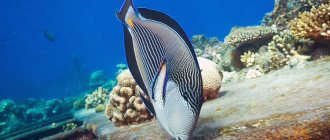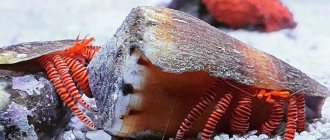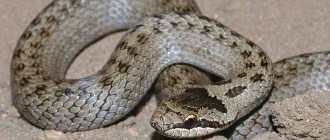Distribution of the river stingray
The river stingray is endemic to several South American river systems. It is native to Brazil's Amazon basin, and although its presence has been confirmed in South American rivers, details of the species' distribution outside the Brazilian Amazon are not yet fully understood. This stingray is also found in Uruguay, Paraná, in the river basins between Paraguay and Orinoco, including the middle and lower Rio Paraná of western Brazil (where it is most abundant), middle Rio Uruguay, Rio Bermejo, Rio -Guapore, Rio Negro, Rio Branco, Rio de Janeiro and Rio Paraguay.
River Stingray
This species has recently spread to many of the upper Amazon and other remote areas due to the construction of hydroelectric dams, which removed natural barriers to migration.
Maintenance and care, arrangement of the aquarium
The optimal aquarium size for a pair of fish starts from 1700 liters. The most acceptable shape of the tank is round without sharp edges. The design is simple and is chosen at the discretion of the aquarist. The main conditions are sandy soil and large open spaces at the bottom. When choosing decor, you should avoid rooting plants, as they will be quickly dug up and damaged. As an alternative, mosses and ferns that can grow on driftwood and stones are suitable. In addition, they are perfectly adapted to grow in low light. This is exactly what should be provided in an aquarium. The filtration system is the most important element in keeping the Ocellated Stingray. The filter is designed to cope with a large amount of organic waste and ensure complete circulation of water at least 4 times per hour, i.e., with a tank volume of 1700 liters, its productivity should be about 7000 liters per hour. In addition, half of the water should be renewed weekly with fresh water. Such requirements imply serious costs for the purchase, installation of equipment and its subsequent maintenance, so such work is usually carried out by individual specialists or professional aquarists with extensive experience.
External signs of a river stingray
River stingrays are distinguished from closely related species by the presence of orange or yellow ocelli on the dorsal side, each of which is surrounded by a black ring larger in diameter than this spot.
External signs of a river stingray
The body color is grayish-brown. The body shape is oval with a powerful tail. The maximum length reaches 100 cm and the largest weight is 15 kg, although stingrays are found much smaller (50-60 cm and weighing up to 10 kg). Females are slightly larger than males.
Needles and poison
Closer to the base, on the long curved tail like a cat's, the stingray has a jagged needle. It reaches 20 cm, in large individuals up to 35 centimeters. The spike has a groove at the bottom in which toxic glands are located. The injection is very painful and poisonous, but does not pose a mortal danger to humans; only in case of panic or convulsions is it possible to choke and die. Throughout its life, the stingray grows up to three spines if one of them breaks during an attack, but sea cats with 2-3 spines are often found.
The fish is not distinguished by its aggressive disposition; in captivity it quickly gets used to and even recognizes its owner, but in natural conditions tragic cases occur. Incidents of attacks on people:
- 2006 - a huge stingray killed famous Australian reptile tamer Steve Irwin with a blow to the chest (heart area) during underwater filming.
- 2016 - Singapore Aquarium employee, professional driver Philip Chen, who worked there for 25 years, was attacked by a stingray and died in hospital from his injuries.
- 2018 - on Lauderdale Beach, off the coast of Tasmania, a stingray killed an Australian with a blow to the stomach; the vacationer suffered cardiac arrest.
The poison of the sea animal has been known for a long time to the Malaysian, Australian aborigines and Central American Indians, who used its thorn in hunting as an arrow point. The Athenian tragedian Sophocles described how Odysseus was killed with just such a spear.
WARNING: The danger is that each jagged groove on the spike contains poison, and the back-curved barbs prevent immediate removal of the toxic needle. Individual intolerance to the toxin, a blow to the heart, multiple injuries and painful shock can also lead to death. There are not many tragic cases, but you should not neglect caution, especially when swimming or fishing on the Black Sea coast, where the sea cat is found in abundance.
Reproduction of river stingray
The timing of reproduction directly depends on the hydrological cycle in rivers and is confined to the dry season, which lasts from June to November. Mating in river stingrays was observed only in the captive population, so there may be differences from the reproduction of wild populations. Mating occurs mainly at night. The male captures the female and clamps his jaws tightly onto the posterior edge of her disc, sometimes leaving noticeable bite marks.
Reproduction of river stingray
It is possible that males mate with several females at intervals of several weeks. River stingrays are ovoviviparous species; their eggs have a diameter of 30 mm.
The female bears the offspring for 6 months, young stingrays appear during the rainy season from December to March (the offspring appear in the aquarium after 3 months). Their number ranges from 3 to 21 and is always odd.
Typically one litter is hatched each year for three consecutive years, followed by several years of reproductive inactivity. The embryos in the female's body receive nutrients from the mother.
Potamotrygon motoro
Young females tend to give birth to fewer babies. Typically a brood consists of 55% males and 45% females. The average length of young stingrays is 96.8 mm. Young stingrays immediately become independent and reproduce when they reach an age of 20 months to 7.5 years.
Information on the lifespan of river stingrays in the wild is unknown. These fish live up to 15 years in captivity.
Character and lifestyle of stingray fish
Stingrays live in shallow water, burrowing into the sand during the day; sometimes a crevice in a rock or a depression under stones can become a resting place. They can pose a danger to humans.
Of course, they won’t attack on purpose. But if they are accidentally disturbed or stepped on, they will begin to defend themselves. The stingray begins to make sharp and strong attacks and pierces the enemy with its spike.
If it hits the heart area, almost instant death occurs. The tail muscles are so strong that the spike can easily pierce not only the human body, but also the bottom of a wooden boat.
When poison enters the body, it causes severe and burning pain at the site of injury. It will gradually subside over several days. Before the ambulance arrives, the victim needs to suck out the poison from the wound and rinse it with plenty of sea water. dragon has a that of the stingray .
To avoid becoming an accidental victim of this stingray, you need to make a loud noise and wave your legs when entering the water. This will scare away the hunter, and he will try to swim away immediately. You also need to be careful when cutting up a stingray carcass. Its poison remains dangerous to humans for a long time.
Despite all this, stingrays are very curious and obedient. They can be tamed and even hand-fed. On the Cayman Islands, there is a place for diving tourists where you can calmly swim next to stingrays , in the company of professional divers, and even take unique photos .
Although stingrays, by their nature, are rather solitary, they often gather in groups of more than 100 individuals near the coasts of Mexico. And they are located in shallow sea depressions, which are called “paradise”.
In European waters, these stingrays can only be seen in summer. When the water temperature drops, they swim to warmer places to “winter,” and some species simply bury themselves deep in the sand.
Behavior of the river stingray
River stingrays migrate to freshwater rivers and streams. The distance over which river stingrays migrate reaches 100 kilometers. The fish live solitarily, except during spawning. During the day you can find stingrays buried in the sand drifts. It is unknown whether these rays are territorial organisms.
River stingrays have eyes located on the dorsal surface of the head, which provide an almost 360° field of vision. The size of the pupil changes depending on lighting conditions. The lateral line senses changes in water pressure with special cells. River stingrays also have a complex system of electrical receptors that provide extremely sensitive perception of low-frequency electrical impulses, which allows them to find prey that is not visible in the water.
River Stingray
In the same way, these fish detect predators and navigate the surrounding aquatic environment. The olfactory organs are located in cartilaginous capsules on the top of the head. River stingrays are hunted by caimans and large fish. However, the jagged, venomous spine on the tail is an important defense against predators.
Lifestyle
In shallow water, on muddy areas of the bottom and even in river estuaries, it is possible to meet a sea cat; it is not for nothing that he received such a nickname. In broad daylight, buried in silt or sand, the stingray rests, slightly waving the tip of its tail (this impression is formed due to the vibrations of the water), waiting for night to fall, and only then goes out to hunt. Mollusks, sea worms and crustaceans (the main food) are the diet of the sea cat. There are cases where stingrays have caused significant damage to oyster farms and mussel farms.
The most interesting thing for scientists is the reproduction of fish; it is viviparous and gives birth to completely independent young. Inside the mother, babies develop in just 4 months, first feeding on substances from the egg yolk, and then switching to mother’s “milk” (histotroph), which is secreted from the walls of the uterus. The litter, which occurs twice a year, contains an average of seven cubs, twisted into a cone-shaped tube so as not to injure the mother upon birth.
Yandex.Pictures
Feeding of the river stingray
The composition of the food of river stingrays depends on the age of the stingrays and the presence of prey in the environment. Soon after birth, young stingrays eat plankton and juveniles, consume small mollusks, crustaceans, and aquatic insect larvae.
Feeding of the river stingray
Adults feed on fish (astyanax, bonito), as well as crustaceans, gastropods, and aquatic insects.
Conservation status of the river stingray
The river stingray is classified as a "data deficient" species by the IUCN. The number of individuals is completely unknown; their secretive lifestyle and habitat in muddy water makes it difficult to study the ecology of these fish. In many regions where river stingrays live, there are no restrictions on the export of freshwater stingrays. In Uruguay, sport fishing for river stingrays is organized. The relatively low demand for this type of fish as a food source helps to reduce the extermination of river stingrays in nature.
If you find an error, please select a piece of text and press Ctrl+Enter.











